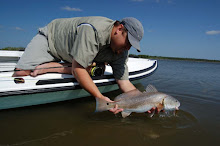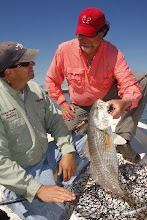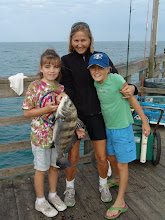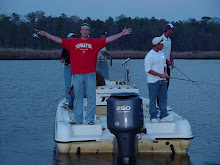FOR IMMEDIATE RELEASE
Coastal Fisheries Reform Group Seeks Immediate Ban on Otter Trawling in NC Waters
Raleigh, NC | Wake County
August 23, 2012
Brownstone Hotel, 1707 Hillsborough Street Raleigh, NC 27605
(919) 828-0811
TIME: 8:30 AM
When the Marine Fisheries Commission meets in Raleigh this week, the Coastal Fisheries Reform Group plans to ask them to implement an immediate prohibition of otter trawling in North Carolina waters.
Extensive studies by scientists at the North Carolina Division of Marine Fisheries have shown that the use of otter trawls by commercial shrimp operations in North Carolina results in the death of hundreds of millions of fish every year. #1.
Otter trawls skim the seafloor as they are dragged along and indiscriminately
crush or drown all species that become trapped. Shockingly, most of the harvest with this gear is not
shrimp, but is actually non-targeted “bycatch” that is discarded after being killed and sorted on the deck of the boat.
Three economically important species, weakfish, spot, and croaker, are hit especially hard by
this practice with a combined total of over 200 million finger-sized fish killed every year. These fish are removed from their nursery area before they mature and never have the opportunity to reach breeding age.
The Marine Fisheries Commission now knows of this extensive damage caused by otter trawls and has the power to immediately force shrimpers to use different fishing gear that will greatly decrease the bycatch as they harvest shrimp. The removal of otter trawls from North Carolina waters is a crucial step in allowing our severely overfished marine resources to recover and the Marine Fisheries Commission is being asked to allow this recovery to begin.
CONTACT: Joe Albea | 252.916.0380
###
#1 1INTERSTATE FISHERIES MANAGEMENT PROGRAM IMPLEMENTATION FOR NORTH CAROLINA By Kevin Brown. Completion Report for NOAA Award No. NA05NMF4741003. Study II DOCUMENTATION AND REDUCTION OF BYCATCH IN NORTH CAROLINA FISHERIES. JOB 2: Characterization of the inshore commercial shrimp trawl fishery in Pamlico Sound and its tributaries, North Carolina June 2010.
Estimates of Cumulative North Carolina Shrimp Trawl Bycatch for Three Important Species
Number of Fish
Year Weakfish Croaker Spot
2007 57,223,380 242,245,642 105,863,253
2008 56,545,008 239,373,867 104,608,265
2009 32,446,248 137,355,783 60,025,559
2010 35,732,010 151,265,509 66,104,219
2011 30,842,160 130,565,144 57,057,996
Totals 212,788,806 900,805,945 393,659,292
The following ratios, which were used to make the table presented above, were determined using North Carolina Division of Marine Fisheries bycatch data:
Weakfish - 6.0 weakfish were caught per pound of shrimp harvested
Croaker - 25.4 croakers were caught per pound of shrimp harvested
Spot - 11.1 spots were caught per pound of shrimp harvested
Reported North Carolina shrimp harvests for the last five years:
2007 = 9,537,230 lbs
2008 = 9,424,168 lbs
2009 = 5,407,708 lbs
2010 = 5,955,335 lbs
2011 = 5,140,360 lbs
The following was presented by the CFRG to the Marine Fisheries Commission at their meeting in Raleigh August 23 2012.
The following was presented by the CFRG to the Marine Fisheries Commission at their meeting Aug 23, 2012 in Raleigh
Blue Print for Renewal of Marine Resources in North Carolina
Overview
For decades North Carolina has relied upon the natural bounty of her coastal rivers, sounds, and estuaries to supply an abundance of commercial and sport fishing opportunities unsurpassed anywhere. Within the memory of middle-aged fishermen is the recollection of plentiful and diverse fish stocks coastwide with no restriction on harvest and no detectable impact on abundance. There seemed to be an inexhaustible supply to support unlimited fishing pressure.
Times have changed. Increasing fishing pressure, the absence of meaningful limits to keep harvest within the confines of productivity, sophisticated fishing techniques, many tons of non-targeted "bycatch", habitat destruction by commercial fishing gear and wetland developments, pollution, and short-sighted management decisions made by policy boards weighted in favor of commercial interests are some of the major factors that have thrown our marine fisheries into turmoil and danger.
Many species of fish previously abundant beyond belief are now depleted and no longer play a role in our fisheries. The river herring, the gray trout, the menhaden, the striped bass, the speckled trout, the red drum, the southern flounder, and even the ubiquitous spot and croaker are all in trouble, overfished, depleted, and struggling in the face of poor management slanted toward immediate returns regardless of long term impacts.
It is now time to draw a line in the sand and say, "No more!". Once our citizens and elected representatives understand how valuable but abused our natural resources are, they too will refrain "No more!".
Our marine resources can and must be managed properly, based upon sound science and current data. No less than total commitment to renewal of these resources is acceptable. The task is formidable but it can be done. Our marine fisheries are resilient and can recover if given the protection and management they deserve and need. The number of people who will be positively affected by such a renewal is astounding with over 1 million North Carolina licensed coastal sport fishermen and women.
We have made some progress recently with the elimination of the menhaden reduction fishery in NC waters, the creation of a rule requiring a super majority of the Marine Fisheries Commission to override a staff recommendation to end overfishing or restore stocks, and a study on the organization of fisheries management programs in North Carolina with a view toward efficiency and effectiveness. In addition, the Governor has upgraded appointments to the Marine Fisheries Commission for greater balance and less special interests by its members. We hope this trend will continue this year with three more good appointments.
Coastal Recreational Fishing
Coastal recreational fishing is a strong and valuable activity to North Carolina and her citizens. Not only is sport fishing a cherished tradition, it generates about $2 billion dollars in revenue every year through direct expenditures of sport fishermen in conjunction with their fishing activities that support many thousands of small businesses and jobs in North Carolina. Coastal recreational fishing is an important driver of North Carolina’s economy that requires no capital investment at all. This is justification enough for expanded emphasis on proper management of this important resource. Renewal of our marine fisheries today will pay tremendous dividends in the near future.
Coastal recreational fishermen have contributed to the decline in fish stocks through past overfishing. Recreational fishermen must be active toward the protection of fish stocks and willing to accept measures required for stock recovery. Recreational fishing rules must be based upon the best available science and enforcement of these rules must be fair, consistent, and vigorous.
Every species of fish must have a management plan that includes harvest quotas and daily bag and size limits based upon current fish stock assessments. The impact of fishing for fun and release must be evaluated and controlled to ensure that mortality is not a problem. For some species, it may be necessary to close the fishing season for periods of time to protect brood stock, foster spawning success, or allow recovery from cold stuns and other negative events.
Allowable gear for recreational fishermen must be carefully prescribed by rule to ensure minimal mortality from hooking for both undersized, targeted fish and non-targeted fish. Such gear as minnow seines, bait traps, cast nets, gigs, and other devices used in conjunction with recreational fishing must be carefully defined and allowed only under circumstances that are compatible with the welfare of the fishery.
Gill nets, strike nets, and trawls have no place in recreational fishing and should be prohibited. The entire concept of "recreational commercial gear" is contradictory and the license that authorizes this activity should be repealed.
Recreational license fees must be reviewed and updated regularly to ensure collection of sufficient funds to support a viable and successful fishery management program. Presently, several fees, including those for both the short term resident and non-resident fishing licenses are too low to generate any funds for management purposes. The use of recreational license fees to support law enforcement as well as fisheries research, habitat enhancement, and fisherman access projects should be allowed. Periodic review of the decision making process controlling the use of recreational license fees should be made.
Equitable representation of recreational fishing interests on decision making boards must be set forth in the fishery management law. The current review of fishery management
programs in North Carolina mandated by the 2012 North Carolina General Assembly and being conducted by the Wildlife Resources Commission, the Division of Marine Fisheries, and the Department of Agriculture should be followed closely to ensure that recommendations coming from this study do not jeopardize in any way the delivery of a sound coastal fishery management program.
Commercial Fishing
While recreational fishing has had its impact on marine fisheries, the damage from commercial exploitation of our fisheries has been far greater. The commercial mindset to maximize harvest and profit by all means, to oppose all regulations, to insist on license fees that are too low to pay for management programs, and to employ sophisticated fishing techniques and gear resulting in overharvest have all led to severe adverse impacts on our marine fisheries.
This adverse impact is not entirely the fault of the commercial fisherman, who is merely trying to make a meager living from the rivers, sounds, estuaries, and ocean. It is the fault of the economically driven industry that profits from the hard and dangerous work of the commercial fisherman. This industry accepts no position other than its own, insisting that our marine fisheries belong to those who exploit them for short term profit without regard for the future.
For years, the commercial fishing industry has had its way with policy making boards, securing lax rules governing seasons and harvest. The recreational fisherman sat quietly by as this blatant mismanagement dragged our marine fisheries into a state of depletion. Even today, in the face of overwhelming evidence of depletion, the commercial fishing industry opposes every conservation proposal advanced by scientists and concerned fishermen. We must develop balanced management that conserves our marine fisheries and enhances our marine habitats. The following steps will begin that process.
Restrictions necessary to bring commercial fishing into balance with the harvest capacity of the resource can be divided into three categories:
1. Gear restrictions.
Very few meaningful restrictive rules on the amount or type of gear are currently in place in North Carolina waters to address habitat destruction and bycatch of non-targeted fish and aquatic life. At a minimum the use of the following gear should be changed as described:
a. Otter trawls.
These destructive devices are dragged in the shallow waters of North Carolina sounds and estuaries, which serve as nursery areas for a variety of juvenile finfish and other aquatic life, to catch mainly shrimp and crabs. In the process of harvesting targeted species, this gear kills many times more non-targeted fish (by weight). Hundreds of millions of fingerling sized fish are wiped out, and most of the dead are species currently listed as Page 4 of 4
overfished or depleted. In addition, otter trawls cause tremendous destruction to the bottom as the trawls are dragged along behind the boat. Obliteration of bottom structure and silt from dredging create formidable obstacles to restoration of productive oyster beds and submerged aquatic vegetation. The use of otter trawls in North Carolina waters should be stopped immediately.
b. Strike nets.
These nets are deployed around schools of fish usually in restricted, in-shore areas where they have gathered for refuge. After the strike net is deployed, the fish are driven into the net by commotion from the netter. Strike nets are particularly damaging when set in inshore areas in late fall and winter when large brood fish move into these waters to spend the cold months. Activity of fish is limited when the water is cold, so the fish are especially vulnerable to strike nets at this crucial time of their life cycle. Because of this, the use of strike nets should no longer be permitted in primary or secondary nursery areas between November 1 and April 1.
2. Bycatch reduction.
Rules must be put into effect to restrict commercial fishing operations so that bycatch mortality is eliminated or reduced to levels that do not affect the abundance or life cycle of the non-targeted fish or other aquatic life. It is no longer acceptable to kill 5 to 10 pounds of non-targeted marine life to catch a pound of shrimp. Federal mandates to eliminate interactions between commercial fishing gear and endangered species such as the Atlantic sturgeon and sea turtles will require changes to reduce interactions or the fishing activity will be closed. Bycatch should be reduced through prohibition or modification of gear, or through seasonal and area restrictions or closures.
3. Total allowable catch (TAC).
TACs are scientifically determined quotas that are set to limit the harvest of a species to levels that are compatible with sustainability. All commercial species should have a TAC established and enforced. TACs should be set in an equitable manner consistent with historical participation or some fair system of lottery. TACs should be set by season or by area when required to allow critical protection during some vulnerable stage of a species life cycle. TACs should also include size limits when appropriate and may be imposed for daily or longer intervals to regulate the rate of harvest.
The sea food industry must adapt and change its approach to harvest. The primary goal of management and regulation must be the sustainability of our marine resources.








.jpg)








